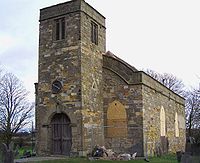
Owthorpe
Encyclopedia


Civil parish
In England, a civil parish is a territorial designation and, where they are found, the lowest tier of local government below districts and counties...
in the English
England
England is a country that is part of the United Kingdom. It shares land borders with Scotland to the north and Wales to the west; the Irish Sea is to the north west, the Celtic Sea to the south west, with the North Sea to the east and the English Channel to the south separating it from continental...
county of Nottinghamshire
Nottinghamshire
Nottinghamshire is a county in the East Midlands of England, bordering South Yorkshire to the north-west, Lincolnshire to the east, Leicestershire to the south, and Derbyshire to the west...
.
Owthorpe is located south east of Nottingham
Nottingham
Nottingham is a city and unitary authority in the East Midlands of England. It is located in the ceremonial county of Nottinghamshire and represents one of eight members of the English Core Cities Group...
and forms part of the borough of Rushcliffe
Rushcliffe
Rushcliffe is a local government district with borough status in Nottinghamshire, England. Its council is based in West Bridgford. It was formed on 1 April 1974 by merging the West Bridgford Urban District, the Bingham Rural District and part of Basford Rural District.-Political representation:The...
. The Grantham Canal
Grantham Canal
The Grantham Canal is a canal that runs for 33 miles from Grantham, falling through 18 locks to West Bridgford where it joins the River Trent. It was built primarily to allow for the transportation of coal to Grantham. It opened in 1797, and its profitability steadily increased until 1841...
is to its east. the borough council records a population of 90 so the parish is too small to have a parish council and has a parish meeting
Parish meeting
A parish meeting, in England, is a meeting to which all the electors in a civil parish are entitled to attend. In some cases, where a parish or group of parishes has fewer than 200 electors, the parish meeting can take on the role of the parish council itself, with statutory powers, and electing a...
instead. It was at one time the seat of the powerful, Hutchinson family. A large manor house was located there until it burned to the ground in a fire. Owthorpe Hall was the manor house of the Hutchinsons, one famous member being John Hutchinson
John Hutchinson (Colonel)
Colonel John Hutchinson was one of the Puritan leaders, and a prominent Roundhead in the English Civil War to the extent of being the 13th of 39 Commissioners to sign the death-warrant of King Charles I.-Biography:...
, the parliamentary army officer and regicide. The family vault under the nave is now sealed off, but when the floor gave way in 1859 it was found to contain 17 coffins.
Owthorpe is a pleasant village with a very unusual church. It sits away from the village surrounded by a low wall in farmland. Access is only along a narrow grass track, muddy in winter months, and through a timber gate. The track and the graveyard are a public footpath. Parts of St Margaret's date from the 12th century. The structure has undergone many changes over the centuries and has recently undergone repairs. The north wall has survived as part of the original, larger church.

